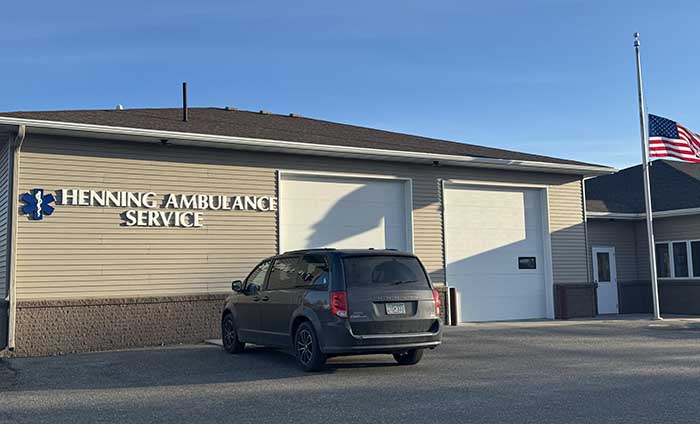Ambulance service in need of more volunteers
News | Published on November 5, 2024 at 3:11pm EST | Author: henningmaster
0
The Henning City Council heard last week about a need for additional people to join the Henning Ambulance Service. The current members have said they are facing burnout in ensuring the 300 square miles coverage area is being serviced each day.
By Chad Koenen
Publisher
The Henning Ambulance Service is facing the same dilemma rural ambulance services are dealing with across the state—what to do about a lack of qualified volunteers.
During a special work session last Monday night, the Henning City Council heard from many current and a former member of the Henning Ambulance Service about how it should move forward with attracting new volunteers to keep the ambulance service operational, while also taking the load off of the current members of the volunteer department.
“It’s no secret, even one of our members who has been on for over 20 years, had made the comment that the Henning Ambulance has been struggling to get people for 20 years. This is nothing new. We are facing the point where we can’t even get people interested,” said Henning Ambulance co-director Chelsey Waskosky.
In order to help address a lack of volunteers within the Henning Ambulance Service, the organization had tried to hire three part-time employees that were paid to cover some of the more difficult shifts to have staffed in recent years. Waskosky said that worked for a while, but recently filling those part-time positions has proved difficult on a long-term basis. The lack of active members on the ambulance service has resulted in several volunteers covering more hours than they would like to ensure the more-than 300 square miles that the Henning Ambulance Service covers is staffed as much as possible. As a result, several members have said they are facing the reality of burnout since many of them already work a full-time job, in addition to their commitment on the ambulance service.
“We are just coming to a point where it is getting difficult to staff and we are burning out really bad. When I have had a talk with some of the major hour holders on the crew, we can’t keep doing this as there is no family life,” said Waskosky. “The burnout is a real thing.”
Henning City Councilman Scott Hart said one of the biggest issues facing the ambulance service is a lack of members. He said the department has a mixture of some very experienced members and several new members on the local service. He said the department is essentially lacking a group of people with 10-15 years of experience, for example.
Throughout the meeting, Hart and city clerk/treasurer Jenna Kovarik said there needed to be a renewed focus on getting people to volunteer for the ambulance service so the work can be spread out to more people. Hart said in coaching he spent a lot of time trying to get the wrestling numbers up to ensure there were always people available to complete the wrestling team. Without enough people in the wresting room, if someone were to quit or get hurt they wouldn’t be able to put together a full team.
Jesse Hermanson said the ambulance committee recently met to try to find ways to get people interested in getting more volunteers to join the Henning Ambulance Service to lighten the load.
Several of the crew members said the compensation for being on call is an issue and could be holding people back. The Henning Ambulance Service pays just $1.50 per hour for being on call, with the pay increasing substantially when a person responds to a call. By comparison, Parkers Prairie pays between $2.50-3.50 an hour in base on call pay with varying pay based on day/night and holidays.
Waskosky said some of the most common concerns she has heard from people she has reached out to regarding joining the ambulance service have revolved around the time commitment and time away from home, as well as being unsure if they would be able to handle the emergency situations. Waskosky said many of the medical calls they receive are not the gory, bloody scenes that people commonly associate with the ambulance service.
Another concern she has raised has to do with volunteerism in general, as a number of local organizations and ambulance services across the region are struggling to find enough volunteers to fill the open spots.
“It’s that giving back to the community. It’s just sad to say that volunteerism just isn’t there in this day in age. I don’t know if it is not being taught, if people don’t feel the need. We are just kind of between a rock and a hard place. It is something that has been going on for a while,” said Waskosky.
Even if the Henning Ambulance Service was able to get a renewed interest from prospective members the change will not happen overnight as new members would need to go through necessary training to begin taking calls.
Waskosky said it takes about 3 1/2 to 4 months, on average, to complete the necessary training to be a member of the ambulance service. She said there are programs available that can complete the training in a shorter period of time as well, but those are more of a boot camp style training.
While the situation in Henning is reaching a critical point, short staffing at an ambulance service is not unique to the community. During the meeting the city council heard that other places like Ringdahl Ambulance Service in Fergus Falls is also struggling to get enough qualified staff members to join the ambulance.
When asked what happens if Henning can’t fill certain shifts on the ambulance service, Waskosky said Henning’s territory would be covered by an adjacent ambulance service. However, that means local residents could wait approximately 30-45 minutes for an ambulance to arrive on the scene.
“We pass it on to the other services that surround us,” she said.
The Henning Ambulance Service can pass on up to 108 hours of service a week to neighboring ambulance services. However, Waskosky said the downside of doing that is the increased response time it will take for an ambulance to respond to the scene.
While it may not be an ideal option, Hart said using hard breaks in call time and utilizing other area ambulance services to avoid further burnout by local ambulance service members may be necessary.
“I want to keep what I have,” said Hart. “If that’s the case then that’s what we are going to have to do. Why would I want to lose you guys if you are burned out.”
The Henning City Council encouraged Waskosky to come up with creative ideas to increase volunteers for the Henning Ambulance Service, which included potential mailers and spreading the word about the dire need for additional people to fill hours on the local service.
If enough people are interested in joining the ambulance service, but are in need of additional training, Waskosky said she could offer a training class after the first of the year in Henning so people wouldn’t even need to leave the community to take the course.
For more information about joining the Henning Ambulance Service, contact the Henning City Office at 583-2402.
